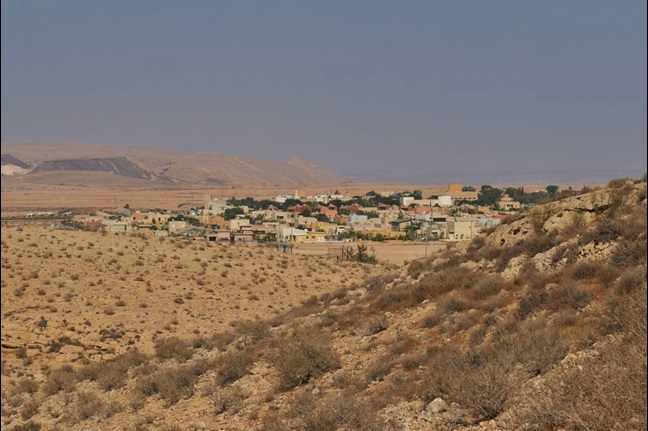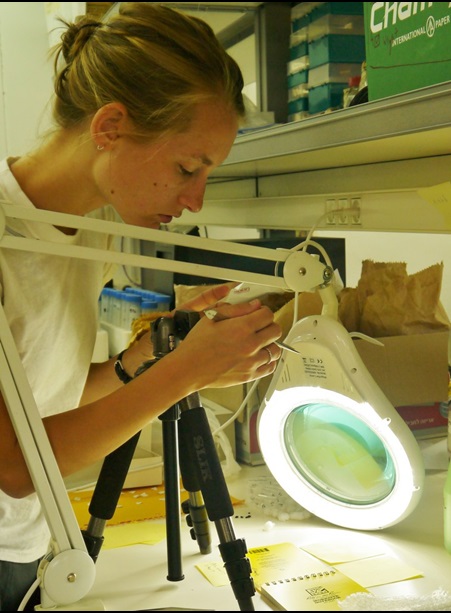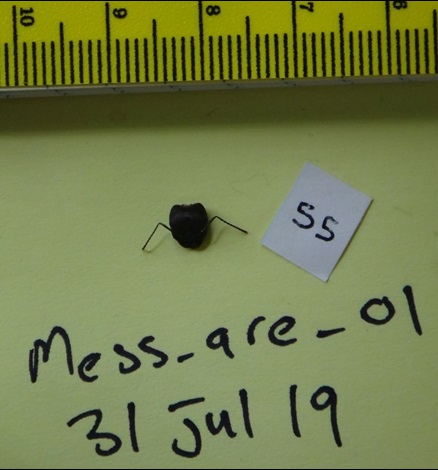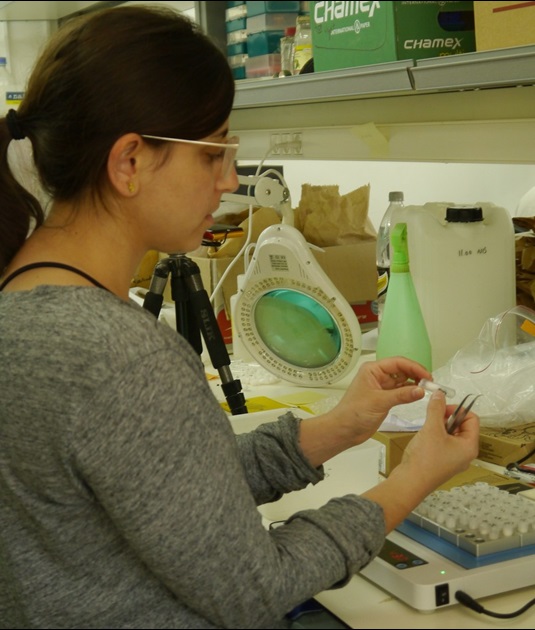A Report from 2018 Stein Fellowship Awardee Sean O'Donnell
August 26, 2019
2019 Stein Fellowship-funded research in Israel Drexel BEES/Biology O’Donnell lab
Hosted by Dr. Itamar Giladi, Sde Boker campus, Ben Gurion University
Dr. O’Donnell traveled to Israel in late July/August with former research associate Dr. Susan Bulova, PhD student Virginia Caponera, and incoming PhD student Karmi Oxman.
Background. In 2018, Dr. O’Donnell contacted Dr. Itamar Giladi to explore potential for a new research collaboration. O’Donnell’s lab focuses on measuring the thermal limits of social insects, mainly ants. Our aim is to understand how temperature variation across the landscape and over time leads to animals’ evolutionary adaptations to their local environments. Giladi’s lab is interested in how desert environments limit the growth and distribution of plants. Giladi works mainly in the Negev desert of Israel. Many Negev desert plants produce seeds at the end of the wet season which remain available as a resource through the dry summer. Several species of Negev desert ants harvest seeds, and these ants can affect plant reproduction: the ants act either as seed predators, or as seed dispersers.
We decided to explore how the thermal limits of desert ants might affect their ability to forage on the surface and collect seeds. Does the body size of ant workers affect how they respond to temperature? Do co-occurring ant species have distinct thermal limits, and could this influence their relative abilities to harvest seeds? To begin answering these questions, we planned to collect pilot data on desert ant thermal limits.
Stein-funded research goals. Our main research goal during the Stein funded trip was to measure thermal tolerance limits of Negev desert ants. The O’Donnell lab has extensive experience testing the maximum and minimum temperatures of ant workers, but our previous field work focused on ants living in the Neotropics. Negev desert ants provided a fascinating system for comparative exploration: we expected the thermal environments of the desert to be much more challenging to the ants. The potential for linking thermal effects on ants with their food source (seeds), and ultimately with the plants they rely on, was appealing A collaboration with a productive desert plant ecology lab offered opportunities for compelling, ecologically relevant extensions of our expertise.
Stein-funded research activities in Israel. We traveled to Israel with the digital hot and cold dry baths that we use to measure the thermal physiology of ants. The facilities at the Sde Boker campus were excellent for conducting our research. We were generously housed in Dr. Giladi’s lab space for making our thermal physiology and body size measurements, and we found enough active colonies of the target ant species on the Sde Boker campus to collect a robust pilot data set.
Seasonality imposed strong constraints on animal activity in the Negev during our visit.
Summer is a dry and hot season; most desert plants have ceased growth, and most animals (including our arthropod research subjects) were active above-ground only in the evening after dusk, in some cases through the night and briefly after dawn. We adjusted most of our data collecting schedule to take advantage of the active periods of the animals.
Research was highly successful. After briefly testing thermal tolerances of thermally robust Cataglyphis ants, we focused mainly on two co-occurring species of seed harvesting Messor ants: M. ebeninus and M. arenarius. These species exploit the same food resource base and had similar summer-time activity periods during our visit, but they differ dramatically in worker body size and in basic foraging strategy. Messor ebeninus has size-variable but relatively small workers that forage in massive directed columns of thousands of individuals; M. arenarius is larger but its workers mainly forage solitarily. We measured maximum and minimum thermal tolerances, and body sizes, on hundreds of ant workers from several colonies each of M. ebeninus and M. arenarius. We collected environmental temperature data at ant colonies during active and inactive periods. We also collected thermal tolerance data on other desert arthropods: desert isopods and termites, and nest/shelter data on termites, isopods, and spiders (see below). We are in the process of analyzing our extensive thermal physiology and body size data sets. We expect our pilot data collection efforts to put us in a strong position to demonstrate feasibility of our project for seeking additional funding (NSF, BSF) to continue the work. Dr. Giladi is committed to working with us to develop a BSF proposal for this project.
Other research opportunities and professional connections. Dr. Giladi’s experience was invaluable to our successful data collection efforts on ant thermal physiology. We also consulted and worked with Drs. Yael Lubin, and Berry Pinshow, and Yoram Ayal.
Following our travels to different sites in the Negev Desert with Ben Gurion University scientists, we recognized opportunities for further research on several species of social arthropods. Particularly promising are:
- Grass-harvesting termites (Anacanthotermes ubachi), which are active uncovered and above- ground, even in the summer.
- Large-bodied desert isopods (Hemilepistus reaumuri), which are monogamous and form family groups with extensive parental care.
- Social spiders (Stegodyphus lineatus), which build enclosed nests and have extensive maternal care of their young.
Thermal biology is likely highly relevant to all these animals, with implications for their social interactions, but is unstudied. In addition to our ant work, we managed to collect some thermal physiology data, as well as observations of nest structure and foraging behavior, on these species. The Drexel PhD students are exploring possibilities for returning to Sde Boker to work more with these systems; Ben Gurion University researchers are supportive and excited about possible collaborations.
Other relevant experiences. Guided by Drs. Giladi, Lubin and Pinshow, we explored several off-campus sites, with the aim of assessing different populations of Messor ants as well as social spiders, termites and isopods. We found Negev sites that could support future field research near Dimona, at the Yeruham Iris Preserve, in Mitzpeh Ramon crater, and near the Avdat Nabatean ruins. O’Donnell gave a well-attended seminar talk to the desert ecology group, which led to additional discussions and contacts with Ben Gurion students and faculty. Several lunch and evening gatherings with groups of colleagues added to the rich intellectual experience, and to our sense of excellent potential for future collaboration.

Research at the oasis-like Sde Boker campus of Ben Gurion University in the Negev focuses on desert studies, including desert ecology.

The dramatic canyons of Ein Avdat national park provide a dramatic backdrop to the Sde Boker campus, and possible field research sites.
Night-time foraging activity at one of our research subject ant colonies- Messor ebeninus.

PhD students Karmi Oxman and Virginia Caponera collecting temperature data at an ant colony on the Sde Boker campus.

PI Sean O’Donnell collecting ant workers from a Messor arenarius colony.


Virginia Caponera photographing ants for body size measurements in Dr. Itamar Giladi’s lab; image of a large ant worker (Messor arenarius) to be used for size measurements.

Karmi Oxman running thermal tolerance trials on ant workers.
The 2019-2020 Stein Family Fellowship competition is now closed. The 2020-2021 Application will be available in Spring 2020. If you are interested in learning more about The Louis and Bessie Stein Family Fellowship and how you can apply, find out more on our website here.